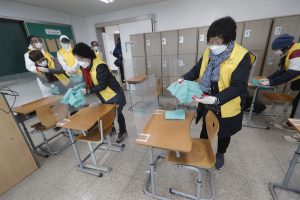South Korea is facing a third outbreak of COVID-19. The current wave, which began in mid-November, is quite different from the outbreaks the country had experienced in late February and August, which were driven by churchgoers, religious leaders, and far right protesters. This time, community transmission is widespread and harder to link to any specific event.
On Sunday, November 29, the government announced it will tighten restrictions in Seoul, the capital of the country, and urban areas that have continuously reported daily confirmed cases. The country recorded more than 500 new COVID-19 cases on three consecutive days last week.
Prime Minister Chung Sye-kyun said that year-end events and parties hosted by hotels, party rooms, and guest houses will be banned. The government had previously raised the greater Seoul area’s social distancing level to 1.5 amid the growing outbreak (South Korea has a five-tier social distancing scale as part of its pandemic management). On Sunday, Chung announced that the level of social distancing restrictions in other urban areas will be raised to 1.5 or 2 according to their specific circumstances and each local government’s decision.
Given that fewer COVID-19 tests are performed on weekends due to the reduction of personnel, the slightly lower number of confirmed cases reported on Saturday and Sunday – 450 and 438 – was by no means a sign that the virus’ spread is being curbed, according to medical experts.
Jeong Eun-kyeong, commissioner of the Korea Disease Control and Prevention Agency (KDCA), said in a briefing on November 30 that “the number of daily confirmed cases can reach from 700 to 1,000” based on their RO calculation.
According to medical experts, the recent spike of COVID-19 cases in South Korea is being driven by two main factors: the weather and the government’s loosening social distancing measures.
Medical experts have constantly predicted that the number of daily confirmed cases will rise as the weather gets colder and people hesitate to gather outside or keep windows open for ventilation.
Alongside warnings from medical experts, the public has demanded that the government take more aggressive measures than ever to overcome what it’s hoped will be the final outbreak of COVID-19, as vaccines and treatments are showing promising signs. But government action has been lagging behind expert advice.
Based on its own social distancing guidelines, the government should have raised the social distancing level from 2 to 2.5, as the number of daily confirmed cases has surpassed 400 consistently for the past weeks. However, instead of raising the level across the board, the government decided to implement a so-called “tweezer policy,” tightening restrictions differently given the number of daily confirmed cases in a specific area. The goal is to limit the impact on the economy.
The Korea Medical Association said in a statement published on December 1 that the government needs to raise the social distancing level from 2 (or 1.5 for areas that have recorded double-digit daily confirmed cases of COVID-19) to 3 temporarily. The KMA argued that is the only effective way to control the spread of the virus at the moment.
“The recent outbreak is a result of a steady stream of community infections that was started in August by the people who attended the rally without keeping social distancing rules,” Hwang Seung-sik, a spatio-temporal epidemiologist at Seoul National University, told The Diplomat. Hwang was referring to an anti-government protest organized in mid-August by South Korea’s right wing.
The organizer of the rally did not provide the police with the exact number of participants, which made it difficult to prevent the spread of the virus nationwide. The police estimated about 3,000 people from various cities attended the rally, but no one knows the exact figure. Hwang thinks that the mass event in August sowed the seeds for the current outbreak.
“It is inevitable for the government to raise or lower the level of social distancing depending on the number of daily confirmed cases until an effective vaccine is released and collective immunity is obtained,” Hwang said, adding that the methods being carried out in Western countries – such as checking for potential exposure using the Bluetooth feature on mobile phones – should be introduced in South Korea.
South Korea has been using high-tech methods of contact tracing to track the movements of people who are diagnosed with COVID-19. But according to Hwang, the health authorities were not able to efficiently track potential contacts according to the movements of confirmed patients.
Meanwhile, on December 3, about 500,000 students are going to take the suneung, South Korea’s most important college entrance exam. To allow the exam to proceed smoothly on schedule, the government and health authorities have asked the public to avoid gatherings and adhere to social distancing guidelines more thoroughly than ever for students’ sake. But more and more people are criticizing the current countermeasures as no longer effective, saying the government should have taken more aggressive measures in advance to prevent possible confusion on the all-important exam day.
The government said on November 29 that it would tighten restrictions and raise the social distancing level if the number of daily confirmed cases keeps rising. This has led some to dismiss the government’s approach as overly reactionary instead of preventative, accusing the government of “mending the barn after the horse is stolen” (using a familiar proverb).
South Korea’s total caseload had climbed to 34,652, with 526 deaths as of midnight on November 30. Of the 451 new coronavirus cases reported that day, 420 cases were locally transmitted and 31 were imported. More than 50 percent of the local cases were caused in the greater Seoul area.

































